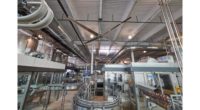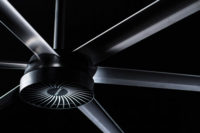Optimizing HVAC systems with new technology can result in a domino effect of benefits. One great example is the high-volume, low-speed (HVLS) fan. These fans can boost HVAC system performance, efficiency, and sustainability. They may even result in lower energy costs.
What Makes HVLS Fans Different?
HVLS fans are often found in warehouses or similar large rooms where managing indoor air quality (IAQ) can be difficult. They are designed to slowly move large amounts of air, maintaining temperatures in expansive facilities. Rather than prioritizing high fan speed, the large blades and slow rotation allow them to circulate air in an energy-efficient manner. This is especially valuable in the sprawling facilities where HVLS fans have a particularly high return on investment.
HVLS fans, which range in blade size from 7 to 24 feet, are typically suspended from the ceiling with no exposed or loose-hanging wires. They can be found in two main motor varieties: gearbox or direct drive. Direct drive motors tend to be lower maintenance and less noisy, making them the ideal choice when available.
HVLS fans prioritize cost and energy efficiency. Fans that can blast high-power cold air all day are expensive and often not as effective at improving air quality as they may seem. By contrast, HVLS fans shine when it comes to improving indoor air quality and boosting HVAC system performance.
Efficient HVAC System Performance
HVAC systems are crucial in large facilities, but they can quickly lead to high energy costs in warm and cold months alike. HVLS fans can lead to noticeable improvements in HVAC system performance, improving efficiency.
It is important to remember that part of what makes hot air so uncomfortable is high humidity. Simply eliminating or dispersing that moisture can make ambient air feel much cooler in any space. This is where traditional high-power fans fall short compared to HVLS fans. An HVLS fan will generate a light breeze that helps evaporate moisture in the air, leading to a cooling effect of 7-11°F. This takes pressure off the HVAC system, boosting performance and reducing energy costs.
This efficiency increase isn’t lost in cooler months, though. The most common challenge building managers face when it comes to heating is the fact that warm air naturally rises. A large facility with high ceilings may have freezing floor temperatures where all the building’s inhabitants are. HVLS fans solve this problem, enabling HVAC system performance to match the needs of the building all year.
It may sound counterintuitive to use fans to increase warmth. However, since HVLS fans rotate slowly, they redistribute warm air instead of eliminating it. This results in consistent, efficient circulation of warm air as the HVLS fan pushes it back down to the floor.
Moisture and Stale Air Management
The cooling and moisture management capabilities of HVLS fans go beyond making facilities more comfortable. Indoor air quality management can be detrimental to the health and well-being of a building’s inhabitants. According to Indventech, one of the top solutions HVLS fans provide is addressing moisture management for building health.
Moisture that builds up in and on ceilings, walls, floors, and other indoor surfaces can result in the accumulation of bacteria and pollutants. Slick surfaces pose a safety risk even when microbial hazards don’t materialize. These hazards are often difficult or impossible to see with the naked eye until they develop into a health threat for the building and people alike.
HVLS fans can prevent all these hazards, though. Slowly circulating air can make a monumental difference in IAQ. HVLS fans ensure fresh air is constantly being distributed. They also eliminate moisture buildup, leading to comfortable and healthier air.
Additionally, HVLS fans can prevent common facility issues such as slick floors that result in what Concrete Construction calls, “sweating slab syndrome” and the resulting inventory damage due to moisture. By evenly and continuously redistributing humid air, HVLS fans prevent moisture from building up on any one surface, no matter the elevation. This is especially helpful in warehouses and restaurants, where moisture buildup can lead to ruined goods and contaminated perishable items.
Using HVLS for Sustainability Initiatives
Sustainability initiatives have become a major priority in virtually every industry over recent years. The great thing about pursuing more sustainable operations is that it often leads to tangible economic and health benefits, as well. HVLS fans are a great example of this.
HVLS fans save facilities significant amounts of energy by enabling HVAC systems to perform at maximum efficiency. This reduces carbon emissions and saves on operating costs. Those savings can then be invested in more sustainable facility improvements. This benefit applies all year since HVLS fans can distribute warm and cold air.
Energy savings can be augmented even further by using HVLS fans in combination with other sustainable building technologies. For example, Revolutionized suggests that a large space could use low-e windows to allow natural light in without compromising insulation. This type of window improves the effectiveness of HVLS fans, which will, in turn, improve HVAC system performance. Low-e windows use a special coating to regulate indoor heat by reflecting excess heat from outdoors and minimizing leakage.
Top HVAC System Performance With HVLS Fans
Improving HVAC system performance can be much simpler than it may seem with the right tools. Adding HVLS fans to a facility can make a world of difference in HVAC performance, resulting in numerous benefits. These fans are a perfect example of working smarter, not harder. They allow facilities to experience healthier air quality, efficient, and sustainable operations, and year-round cost savings.





